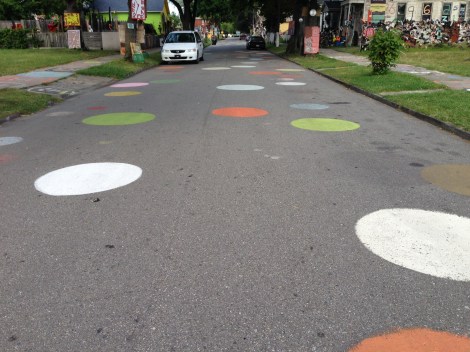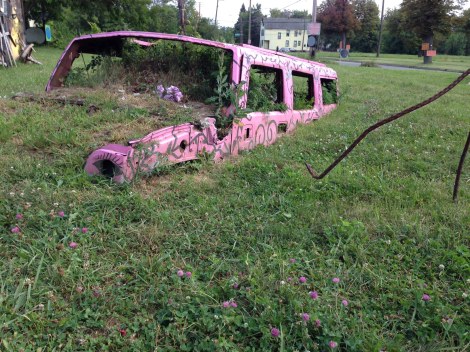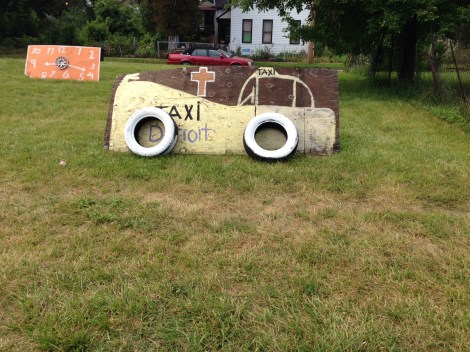I stopped by the Heidelberg Project on my last day in Detroit. I had read about it for years — the travails of the artist Tyree Guyton who, as the houses in his neighborhood began to empty out and fall apart in the ’80s, turned them into exuberant, almost hallucinatory works of art.
As I interviewed people about the situation in Detroit — the housing, the water, the transportation — a particular rumor kept coming up: Someone was trying to burn down the Heidelberg Project. There had been nine fires since last spring, and several of the most famous houses, including the House of Soul, had burned to the foundations. It was clearly arson, but the fires remained unsolved.
When I turned down Heidelberg Street, the first thing I saw was the dots, painted directly onto the asphalt, like some kind of alien landing strip.
 The next thing that I noticed were the pedestrians. Except for the few blocks around Campus Martius downtown, the sight of people just strolling around and chatting is not a common one. Half of them seemed to be on dates with each other.
The next thing that I noticed were the pedestrians. Except for the few blocks around Campus Martius downtown, the sight of people just strolling around and chatting is not a common one. Half of them seemed to be on dates with each other.
And then I saw the project itself. The Detroit neighborhoods that I had gotten used to seeing — house, house, tumbledown house, vacant lot, house, burned house, pile of rubble, house with tree growing up through roof, house — became bright and candy-colored, and very, very weird.

I’ve seen a lot of found-object art in my day, and often the effect can be creepy and sad. This wasn’t. Sculptures made of children’s toys and bowling trophies and other detritus of suburban life emerged from the ground in a way that seemed almost geologic. More of this detritus wrapped around trees like ivy, and other factions of it appeared to be having a picnic on the floor of a house that had been burned to the foundation. Evidence of the arson was unmistakable, but it had been adapted to, and incorporated into, the whole. Paintings of taxis were everywhere, some with real car tires propped up against them. Clocks were everywhere too, each set to a different time.

“Hello!” a man standing across the street yelled.
“Hello!” I yelled back, and introduced myself.
“I made this,” he said. He looked like Guyton, all right.
“I’m sure you get this all the time,” I asked. “But why all the clocks?” I said.
“What time is it?” Guyton said.
“I don’t know,” I said.
“5:45?” said one of the tourists standing behind Guyton, helpfully.
“No, that’s not what I meant,” said Guyton. “I mean, what time is it really? Plato once said that ‘Time is the moving image of eternity.’ What time is it?”
“I’m going to have to think about that one,” I said. “What about the taxis?”
Guyton waved his arm like he was peeling back a curtain that lay over the neighborhood. “Where do you want to go?”
“I don’t know,” I said. “Where do you want to go?”
“You said you were a journalist,” said Guyton. “When you write something, you’re creating reality. I created this reality because I wanted people to come to a place that they would be too scared to go to otherwise.”
Guyton was right. It’s hard for most outsiders to understand just how terrified suburbanites are of Detroit, and how they teach that fear to each other. When I was growing up in the suburbs, we knew that we had passed 8 Mile and entered the city limits when whichever parent was driving the car would suddenly shriek, “lock your doors!”
These days, art gets a bad rap for being a lever used by the forces of real estate. Cities like Los Angeles will plant a concert hall or an art museum in a down-and-out neighborhood, and sure enough more and more people will show up, wanting to be near it. It’s good to remember that art — however strange or tacky or seat-of-the-pants — also has that power to shift the way that people interact with the city. It’s a lever, sure, but one that can be applied to many different ends.



